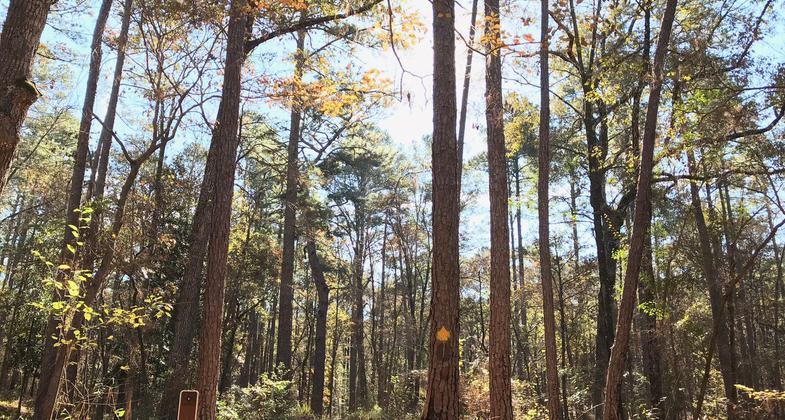Wild Azalea Trail
check with the trail manager for updated details before visiting.
Wild Azalea Trail
USDA Forest Service
Backcountry Trail
- Length
24 miles
- Elevation Gain
--
- Route Type
out & back
(1 review)
- Length
24 miles - Elevation Gain
-- - Route Type
out & back

Mile 1 Marker. Photo by J Aubrey Bolen.

Long Branch Creek in Segment 5. Photo by J Aubrey Bolen.
Location: Kisatchie National Forest, west of Alexandria, joins Valentine Lake to United States Highway 165.
- States: Louisiana
- Counties: Rapides
If you are starting at the Valentine Lake end (as mapped), the trail starts with rolling hills and pines. You'll pass near a fire tower built in the 1930s. The first major creek you'll cross (Valentine Creek) doesn't present much of an issue, but there is a pretty good incline on the opposite side. After the creek, expect more rolling hills as the trail heads deep down into several smaller creek areas and the Wild Azalea Seep.
Around mile 7.5, there is a great camping spot by Lamotte Creek where a well-constructed bridge aids your passage. At mile 9, you'll come across the Evangeline Primitive Camp, which has a bathroom but no running water. From here, the trail heads eastward then southwestward, running parallel to Boggy Bayou. The trail becomes hilly again around the 11-mile mark until you reach Castor Creek Scenic Area. This lower area has several creek crossings, where some have bridges, but others may require you to get your feet wet.
From mile 13 to 19.5, the terrain is strenuous because of creek crossings, rugged terrain, and frequent hill climbing. From this point, the next 5.5 miles follow more rolling hills, although this time with fewer creek crossings. This area has some blown-down trees from a tornado in 2016. The last 1.7 miles are pretty much a road hike to the southern terminus parking area in Woodworth.
There are six vegetation communities found along the trail: bottomland hardwoods, upland hardwoods, mixed-pinioned hardwoods, pure pine, bogs, and natural open spaces. There have been sightings of wild horses, bald eagles, boars, deer, and red-cockaded woodpeckers.
The Castor Creek Area is at the junction of Brushy Creek and Castor Creek that features a variety of large loblolly pine, gum, ash, beech, magnolia, and bald cypress trees.
The area known as the "Wild Azalea Seep" is noted for the unique plants it supports. This is an excellent example of how an acid seep can be home to several species of orchids and the only known population of bog moss west of the Mississippi River.
Accessibility Information
No text provided.
Reviews
Louisianas longest National Recreational Trail
The Wild Azalea Trail is a 24 mile continuous National Recreation Trail located in the Evangeline Unit of Kisatiche National Forest. This trail is not a loop. It is open to foot and bike traffic. Dogs must be on a leash. The trail is marked with yellow diamond reassurance markers. There are multiple trailheads/parking areas along the trail. The western terminus is located close to Valentine Lake and the eastern terminus trailhead/parking area is located close to Woodworth Louisiana. The only vault toilets are locates at the Evangeline primitive camp trailhead, between mile 8.5-9. Fairly well maintained tread way , with good water sources except for the last 7 miles (17-24 mile)
Allowed Uses:
Bicycling Dogs, on leash Hiking/WalkingOther Activities
- Camping
- Wildlife viewing / observation
Public Contact
Glenn ColemanUS Forest Service
9912 Hwy. 28 West
Boyce, LA 71409
[email protected] • (318) 793-9427
Contact the trail manager for current maps and visiting details.
More Details
- Elevation (low): 220
- Elevation (high): 70
- Elevation (cumulative): --
- Part of a Trail System? No
- Surface (primary): Soil
- Surfaces (additional): Soil
- Tread Width (average): 48"
- Tread Width (minimum): --
- Running length (minimum): --
- Tread Grade (average, percent): 1
- Tread Grade (maximum): 10
- Running length (maximum): --
- Cross-slope (average, percent): --
- Cross-slope (maximum): --
- Running length (maximum): --
- Certified as an NRT
Jun 6, 1978

